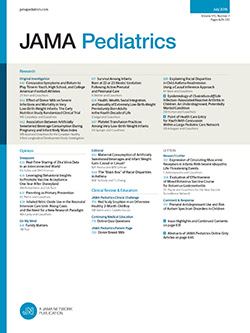Low-Intensity Social Care and Child Acute Health Care Utilization
IF 24.7
1区 医学
Q1 PEDIATRICS
引用次数: 0
Abstract
ImportanceSocial care could be sustained with savings resulting from reduced acute health care utilization.ObjectiveTo evaluate the impact of CommunityRx, a low-intensity, high-scale social care assistance intervention.Design, Setting, and ParticipantsThis double-blind randomized clinical trial took place from November 2020 through August 2023 at an urban children’s hospital with 12-month follow-up. Inclusion criteria were primary caregiver of a child younger than 18 years who was hospitalized in general, intensive care, or transplant units, living in 1 of 42 zip codes, and consenting to text messages. Caregivers of healthy newborns and children with expected hospitalization less than 24 hours or longer than 30 days were excluded.InterventionsParticipants were randomized to usual care (n = 320) or usual care plus CommunityRx (n = 320). Essential intervention components included education about common social conditions, personalized information about local resources, and ongoing navigator support with automated, proactive text messages (3 months) and ongoing availability for participant-initiated requests (12 months).Main Outcomes and MeasuresPreplanned analyses focused on food insecure (FI) subgroup outcomes (n = 223): self-efficacy for finding resources at 12 months (primary), caregiver-reported child health, and number of child emergency department (ED) and hospital admissions over 12 months. Regression models were fit with treatment group and baseline outcome characteristics. Odds ratios (ORs) or incidence rate ratios (IRRs) and 95% CIs were calculated. Post hoc analysis examined outcomes among the food secure (FS) subgroup (n = 414).ResultsPreplanned analyses included 223 FI participants and most identified as female (180 [95%]) and had household income less than $50 000 per year (197 [91%]). Self-efficacy at 12 months was similar among treatment groups (OR, 0.59; 95% CI, 0.25-1.39,低强度社会关怀与儿童急性医疗保健利用
重要性社会保健可以通过减少急症医疗保健利用而节省的费用来维持。目的评价低强度、高规模社会关怀援助干预措施CommunityRx的效果。设计、环境和参与者这项双盲随机临床试验于2020年11月至2023年8月在一家城市儿童医院进行,随访12个月。纳入标准为:在普通病房、重症监护室或移植病房住院的18岁以下儿童的主要照顾者,居住在42个邮政编码中的1个,并同意发送短信。健康新生儿的护理人员和预计住院时间少于24小时或超过30天的儿童被排除在外。干预措施:参与者被随机分为常规治疗组(n = 320)或常规治疗加CommunityRx组(n = 320)。基本的干预成分包括关于常见社会条件的教育、关于当地资源的个性化信息、持续的导航器支持(3个月)和持续的对参与者发起的请求的可用性(12个月)。主要结局和测量方法重新计划的分析侧重于食物不安全(FI)亚组结局(n = 223): 12个月时寻找资源的自我效能感(主要)、照顾者报告的儿童健康状况、12个月内儿童急诊科(ED)和住院人数。回归模型与治疗组和基线结局特征拟合。计算优势比(ORs)或发病率比(IRRs)和95% ci。事后分析检查了粮食安全(FS)亚组(n = 414)的结果。结果预计划分析包括223名FI参与者,其中大多数为女性(180人[95%]),家庭年收入低于5万美元(197人[91%])。治疗组12个月时的自我效能感相似(OR, 0.59;95% ci, 0.25-1.39, p = .23)。在3个月时,当自动导航文本结束时,53名干预组参与者(69%)和39名对照组参与者(45%)将他们孩子的健康评为优秀或非常好(or, 2.67;95% ci, 1.14-6.24)。出院后12个月,54名FI儿童(41%)就诊1次或1次以上(中位数,0;0-32范围;干预,30%;控制,52%;IRR, 0.40;95% CI, 0.21-0.76)和32例有1次或1次以上住院(24%)(中位数,0;范围0 - 5;干预,15%;控制,34%;IRR, 0.48;95% ci, 0.21-1.06)。干预对FS照顾者的结果没有影响。结论及相关性从儿童住院开始的低强度、高规模的社会护理援助干预可能通过降低急性医疗保健利用而持续,但并没有增加护理者寻找资源的自我效能感。临床试验注册号:NCT04171999
本文章由计算机程序翻译,如有差异,请以英文原文为准。
求助全文
约1分钟内获得全文
求助全文
来源期刊

JAMA Pediatrics
PEDIATRICS-
CiteScore
31.60
自引率
1.90%
发文量
357
期刊介绍:
JAMA Pediatrics, the oldest continuously published pediatric journal in the US since 1911, is an international peer-reviewed publication and a part of the JAMA Network. Published weekly online and in 12 issues annually, it garners over 8.4 million article views and downloads yearly. All research articles become freely accessible online after 12 months without any author fees, and through the WHO's HINARI program, the online version is accessible to institutions in developing countries.
With a focus on advancing the health of infants, children, and adolescents, JAMA Pediatrics serves as a platform for discussing crucial issues and policies in child and adolescent health care. Leveraging the latest technology, it ensures timely access to information for its readers worldwide.
 求助内容:
求助内容: 应助结果提醒方式:
应助结果提醒方式:


